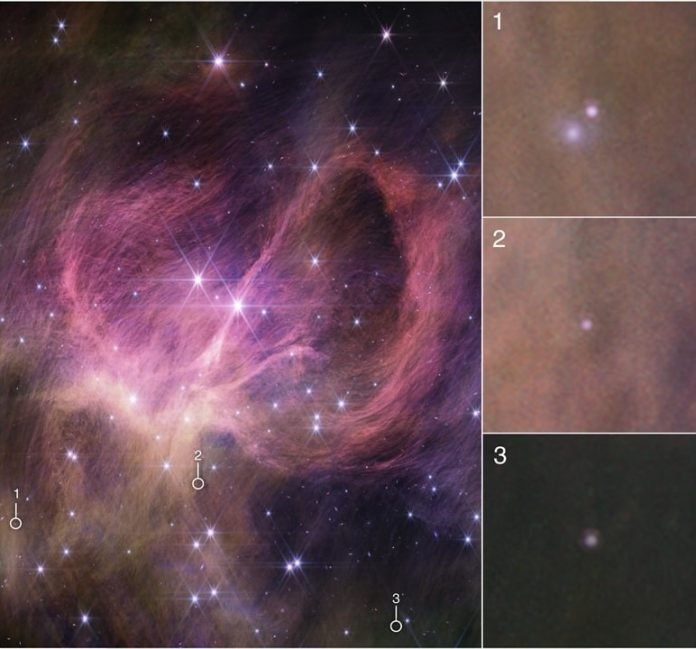Stars have a life cycle spanning a few million to trillions of years. They are born, undergo changes with the passage of time and finally meet their end when fuel runs out to become a very dense remanent body. The burnt-out star could be a white dwarf or a neutron star or a black hole depending upon original mass of the star.
Life of a star begins in large interstellar clouds of gas and dust in the galaxy with clumping of gases due to low temperature to high density pockets. The clumps gradually gather more and more matter and grow. At some point, clumps collapse due to increased gravitational force. The friction during collapse heats up the matter and a baby star is born. This is protostar stage in the stellar life cycle.
The collapse under gravity continues further. As a result, temperature and pressure in the core continue building up. After millions of years, temperature and pressure in the core of protostar become high enough to allow nuclei of hydrogen to fuse. Nuclear fusion release huge amount of energy which heats up the matter sufficiently to prevent further collapse under gravity. This stage when nuclear fusion is stably taking place (and the released energy sufficiently heats up the matter to prevent gravitational collapse) is the main stage and the longest phase in the life of a star. Stars at this stage are called ‘main sequence stars’ and the stage is called ‘main sequence stage’. Hydrogen is the main fuel of the star. Rate of fuel consumption depends on mass of the star. A massive star will consume fuel at higher rate to release sufficient energy to prevent its collapse under gravity.
When fuel runs out, nuclear fusion stops and there is no energy to heat materials to balance force of gravity and the core collapses under gravity, leaving behind a compact remanent. This the end of the star. The dead star becomes either white dwarf or neutron star or black hole depending upon mass of the original star.
When the mass of the original star is less than 8 times mass of sun (<8 M⦿), it becomes a white dwarf. The dead star becomes a neutron star, when the mass of the original star is between 8 to 20 solar masses (8 M⦿ < M < 20 M⦿) while stars heavier than 20 solar masses (>20 M⦿) become black holes when fuel runs out.
Brown Dwarfs (BDs)
Stars reach ‘nuclear fusion stage’ or ‘main sequence stage’ in their life cycle. What if a celestial object forms like a star but fails to reach this stage?
Brown dwarfs begin like a star, become dense enough to collapse under its gravity but its core never become sufficiently dense and hot to initiate nuclear fusion hence never become a true star. These objects are similar in features to both stars and planets.
Black dwarfs are smaller than the stars but still much bigger than the planets. Some smaller ones are comparable in size to planets. The smallest known is about seven times size of Jupiter.
Black dwarfs are important for model of star formation in interstellar clouds of gases and dust. Attempts are being made to determine smallest bodies that form in a star-like manner.
The smallest Brown Dwarf
Recently, researchers surveyed the centre of the star-forming cluster IC 348 situated about 1,000 light-years away using the James Webb Space Telescope (JWST). Based on photometry of the objects, the team identified three black dwarf candidates. One of them is only three to four times the mass of Jupiter which makes it the smallest black dwarf known so far.
A black dwarf three times the Jupiter mass would be 300 times smaller the sun. How such small black dwarf could form in a star-like manner is difficult to explain because a small interstellar cloud would not normally collapse to give rise to a black dwarf due to its weak gravity. Thus, such a small black dwarf poses a challenge before current models of star formation.
***
References:
- Luhman K.L., et al 2023. A JWST Survey for Planetary Mass Brown Dwarfs in IC 348. The Astronomical Journal, Volume 167, Number 1. Published 13 December 2023. DOI: https://doi.org/10.3847/1538-3881/ad00b7
- NASA’s Webb Identifies Tiniest Free-Floating Brown Dwarf. Posted 13 December 2023. Available at https://www.nasa.gov/missions/webb/nasas-webb-identifies-tiniest-free-floating-brown-dwarf/
***






































